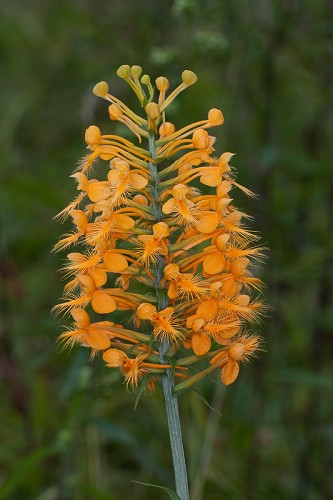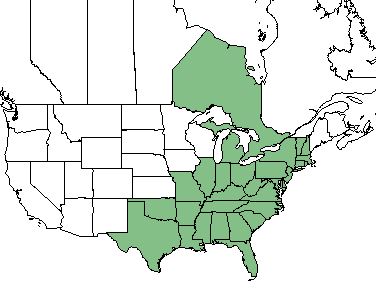Difference between revisions of "Platanthera ciliaris"
(→Phenology) |
|||
| Line 39: | Line 39: | ||
<!--Natural communities, human disturbed habitats, topography, hydrology, soils, light, fire regime requirements for removal of competition, etc.--> | <!--Natural communities, human disturbed habitats, topography, hydrology, soils, light, fire regime requirements for removal of competition, etc.--> | ||
===Phenology=== | ===Phenology=== | ||
| − | Flowers are known to bloom between July and September. <ref name= "Pan Flora"> [http://www.gilnelson.com/PanFlora/ Pan Flora]</ref> | + | Flowers are known to bloom between July and September. <ref name= "Pan Flora"> [http://www.gilnelson.com/PanFlora/ Pan Flora]</ref> When flowering it prefers full sun; it has been observed that there are less dense flowers when lacking full sun. .<ref name ="FFE">Observation by Floyd Griffith in Washington County, Fl., August 9, 2016, posted to Florida Flora and Ecosystematics Facebook Group August 9, 2016. </ref> |
<!--===Seed dispersal===--> | <!--===Seed dispersal===--> | ||
<!--===Seed bank and germination===--> | <!--===Seed bank and germination===--> | ||
| Line 45: | Line 45: | ||
<!--===Pollination===--> | <!--===Pollination===--> | ||
<!--===Use by animals===--> <!--Herbivory, granivory, insect hosting, etc.--> | <!--===Use by animals===--> <!--Herbivory, granivory, insect hosting, etc.--> | ||
| + | |||
===Diseases and parasites=== | ===Diseases and parasites=== | ||
Slugs, snails, and cutworms are known to be pests for the ''P. ciliaris''.<ref name= "USDA"> [https://plants.usda.gov/core/profile?symbol=CEAM USDA Plant Database]</ref> | Slugs, snails, and cutworms are known to be pests for the ''P. ciliaris''.<ref name= "USDA"> [https://plants.usda.gov/core/profile?symbol=CEAM USDA Plant Database]</ref> | ||
Revision as of 12:52, 29 June 2018
Common Names: yellow fringed orchid [1]
| Platanthera ciliaris | |
|---|---|

| |
| Photo by John Gwaltney hosted at Southeastern Flora.com | |
| Scientific classification | |
| Kingdom: | Plantae |
| Division: | Magnoliophyta - Flowering plants |
| Class: | Magnoliopsida - Dicots |
| Order: | Orchidales |
| Family: | Orchidaceae |
| Genus: | Platanthera |
| Species: | P. ciliaris |
| Binomial name | |
| Platanthera ciliaris (L.) Lindley | |

| |
| Natural range of Platanthera ciliaris from USDA NRCS Plants Database. | |
Contents
Taxonomic Notes
Synonyms: Habenaria ciliaris (Linnaeus), Blephariglottis ciliaris (Linneaus)
Variety: none
Description
P. ciliaris is a perennial forb/herb of the Orchidaceae family that is native to North America. [1]
Distribution
P. ciliaris is native to the eastern United States, reaching as far west as Texas, as well as Ontario, Canada. [1]
Ecology
Habitat
Native habitat for P. ciliaris includes bogs, swamps, marshes, wet sandy barrens, thickets that border streams and ponds, moist woods, wet meadows, praires, and deep humus of upland forests. [1]
Shaded areas or partial sun is ideal for this orchid. Also, slightly acidic soils are ideal. [1]
Phenology
Flowers are known to bloom between July and September. [3] When flowering it prefers full sun; it has been observed that there are less dense flowers when lacking full sun. .[4]
Diseases and parasites
Slugs, snails, and cutworms are known to be pests for the P. ciliaris.[1]
Conservation and Management
Due to habitat loss, harvesting, and land management practices such as fire suppression, there has been a decrease in P. ciliaris. It has been listed as threatened in Connecticut, Florida, Maryland, Michigan, Ohio, and Pennsylvania. It is also listed as endangered in Illinois, Indiana, new York, and Rhode Island. Canada is considered to be locally extinct. [1]
Cultivation and restoration
Photo Gallery
References and notes
- ↑ 1.0 1.1 1.2 1.3 1.4 1.5 1.6 USDA Plant Database
- ↑ URL: http://herbarium.bio.fsu.edu. Last accessed: June 2018. Collectors: R.A. Norris, Leon Neel, R.K. GOdfrey, R. Komarek, Cecil SLaughter, Steve Gatewood, DB Ward, S.S> Ward, R. Kral, O. Lakela, Lovett E. Williams, M. Morgan, Angus Gholson, Steve Orzell, Edwin Bridges, Gary Knight, Sidney McDaniel, Wilson Baker, Chris THompson, Michael J. DeVuyst, K. Craddock Burks, S.W. Leonard, Robert Thorne, A.E. Radford, R.B. Channell,, H. F. L. ROck, R.M. Schuster, Randy Warren, David M. DuMond, S. B. Jones, Jean Wooten, R.F> Chrsitensen, C.C. CHristensen, John Nelson, J.R. Burkhalter, F.R. Hedges, Rob Buda, S.L. Orzell, E.L. Bridges, P. Sheridan, L.M. Kane. States and counties: Georgia (Thomas, Ben Hill, Murray, Toombs, Colquitt) FLorida (Jefferson, CLay, Madison, Orange, Nassau, Walton, Bay, Santa Rosa, Leon, Suwannee, Highlands, Pasco, Escambia, Jackson, Jefferson) North Carolina (Alleghany Pender) Virginia (Roanoke, Brunswick, Giles) Mississippi (Perry, Lamar, Jackson, Covington, Kemper) Alabama (Cullman, Baldwin, Mobile) South Carolina (Oconee, Fairfield)
- ↑ Pan Flora
- ↑ Observation by Floyd Griffith in Washington County, Fl., August 9, 2016, posted to Florida Flora and Ecosystematics Facebook Group August 9, 2016.